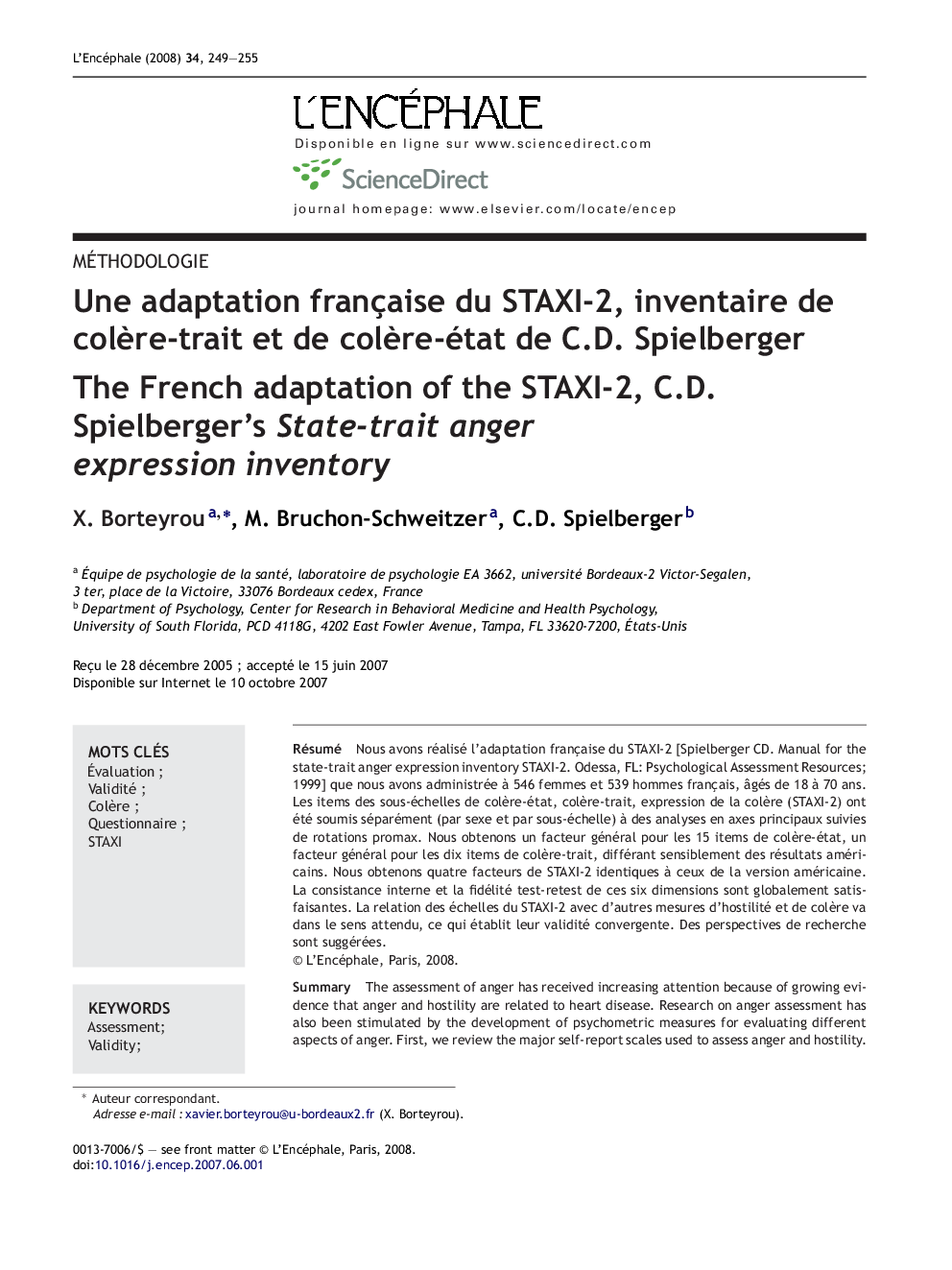| کد مقاله | کد نشریه | سال انتشار | مقاله انگلیسی | نسخه تمام متن |
|---|---|---|---|---|
| 4182634 | 1277201 | 2008 | 7 صفحه PDF | دانلود رایگان |
عنوان انگلیسی مقاله ISI
Une adaptation française du STAXI-2, inventaire de colère-trait et de colère-état de C.D. Spielberger
دانلود مقاله + سفارش ترجمه
دانلود مقاله ISI انگلیسی
رایگان برای ایرانیان
کلمات کلیدی
موضوعات مرتبط
علوم پزشکی و سلامت
پزشکی و دندانپزشکی
روانپزشکی و بهداشت روانی
پیش نمایش صفحه اول مقاله

چکیده انگلیسی
The assessment of anger has received increasing attention because of growing evidence that anger and hostility are related to heart disease. Research on anger assessment has also been stimulated by the development of psychometric measures for evaluating different aspects of anger. First, we review the major self-report scales used to assess anger and hostility. The scales appeared to have been constructed without explicit definition of anger and there is little differentiation between the experience and expression of anger. The factor-derived STAXI-2 is a 57-item measure of the expression of anger, and is comprised of the state-trait anger scale [Spielberger CD, Jacobs G, Russell JS, Crane RS. Assessment of anger: the state-trait anger scale. In: Butcher JN, Spielberger CD, editors. Advances in personality assessment, 2. Hillside, NJ: Erlbaum; 1983] and the anger expression scale (AX; Spielbeger et al., 1985). The state anger scale (SAS) includes three subscales: feeling angry, feeling like expressing anger verballly, and feeling like expressing anger physically. The trait anger scale (TAS) consists of two subscales: angry temperament and angry reaction. The AX deals with the direction of both anger expression and anger control, resulting in four revised AX subscales: anger expression/out (verbal and physical, aggressive behavior directed toward other persons or objects), and anger expression/in (anger suppression), anger control/out (attempts to monitor and prevent the outward expression of anger) and anger control/in (active attempts to calm down and reduce angry feelings). The aim of this work was to examine the factor structure and the psychometric properties of the French adaptation of STAXI-2. A sample of 1085 French subjects, 546 female and 539 male, between 18 and 70 years old participated in the study. The 57 items of the three original subscales (SAS, TAS, and AX scale) were analyzed separately by sex and by subscale, using exploratory factor analyses (principal axis analysis, followed by promax rotations). For the first part of the questionnaire (SAS), factor analysis suggested the presence of three factors with eigenvalues >1.0; but the factor structure obtained for males and females differed and was difficult to interprete. Moreover, the explained variance of Factors 2 and 3 was low. Velicer's MAP criteria and scree test established that one solution factor was more relevant. Confirmatory factor analysis sugested that the three factor solution was acceptable, but the unifactorial solution adjusted better to the data. For the second part of the questionnaire (TAS) factor analysis was conducted following the same procedure, and two factors were extracted. The explained variance of Factor 2 was very low. Velicer's MAP criteria and scree test suggested that the solution factor was more relevant. Moreover, the adjustment parameters of the original two-factor structure were not satisfactory. Finally, the analyses of the 32 items of anger expression and control yielded four factors with eigenvalues >1.0. All items loaded higher than 0.38 on the corresponding factor and lower than 0.30 in other factor. The factor structure of the AX scale was fairly robust, both for males and females. Internal consistency and test-retest reliability of the subscales were acceptable except for the SAS. The correlations of the six subscales with four criterion variables (Buss Durkee hostility inventory, Cook and Medley Ho scale, NEO PI-R Ho scale and Courtauld emotions control scale) were in the expected direction, establishing their convergent validity. In summary, the analysis reported in this study checked the factor structure of the STAXI-2 translated into French. The state anger dimension was also essentially confirmed, but no distinction was found between the three components: feeling angry, feeling like expressing anger verbally, and feeling like expressing anger physically. Moreover, the distinction between angry temperament and angry reaction was not confirmed because of gender differences, but we established a robust and valid trait anger factor. Finally, we confirmed the factor structure of the original anger expression scale without gender differences. Some practical and theoretical perspectives for the use of the French adaptation of the STAXI-2 are suggested.
ناشر
Database: Elsevier - ScienceDirect (ساینس دایرکت)
Journal: L'Encéphale - Volume 34, Issue 3, June 2008, Pages 249-255
Journal: L'Encéphale - Volume 34, Issue 3, June 2008, Pages 249-255
نویسندگان
X. Borteyrou, M. Bruchon-Schweitzer, C.D. Spielberger,